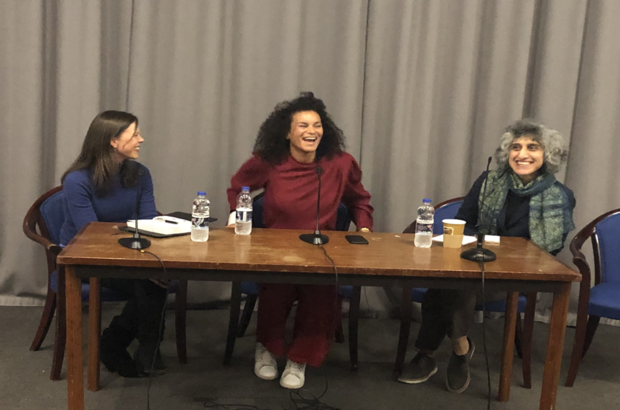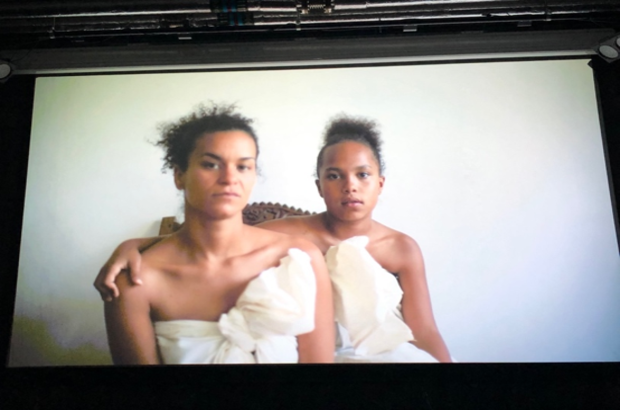FARIDA EL KAFRAWY reviews Philippa Ndisi-Herrmann’s 2018 documentary, New Moon, chronicling her conversion to Islam.
What begins as an audiovisual journey, charting the changing landscape and cultural fabric of life on Kenyan island town Lamu amid construction of a local coal plant, gradually and delicately transforms. Philippa Ndisi-Herrmann’s New Moon (2018) develops into an exploration of the director’s own shifting sense of identity throughout a period of spiritual conversion to Islam.
Returning to the country in which she was raised as a child, Ndisi-Herrmann seeks to witness change occurring around her. Instead, as she explains in the intimate ERC-funded ‘Screen Worlds’ screening and Q&A session at SOAS, University of London, the project progresses very slowly, failing to capture the levels of change she had anticipated. Curiously, while life in Lamu remains relatively untouched, it is Ndisi-Herrmann who is gradually starting to develop. She slowly unearths a completely different sense of personal identity through the creative experience of becoming the protagonist of her own documentary. All too used to being director, observer and interpreter, Ndisi-Herrmann becomes the subject during her quest for something sensitive and profound hidden within the commonplace and quotidian.

None of the material shot was intended to be used for a film about the director’s own life. After the idea of creating a powerful documentary about the port project became unfeasible due to laws preventing criticism of the government, Ndisi-Herrmann decided to make the documentary about the life of a Muslim boy in Lamu. Ahmed, the son of her friend Raya, would thus become the protagonist.
Ahmed still features heavily in the film, taking on the role of a spiritual guide in many ways. We see him reciting prayers for the dead as he walks past a graveyard on his way to school, attending Madrasah (Quran school) and reciting Quran. He often repeats prayers at the director’s request, slowly, so that she can memorise and repeat later. Ndisi-Herrmann describes the prayers as hypnotic, beautiful and incredibly peaceful. This aspect of Islam appeals to her, as do the words of Rumi, and the Sufi way of following Islam.
However, we see her hesitation as she becomes drawn to the religion, her worries about what is often perceived as the demands of Islam on women. She does not want to wear a hijab or accept the idea of her future husband being allowed to marry more than one woman. The director’s friend Raya is a third wife herself and we see a very honest and vulnerable kitchen conversation between them about polygamous relationships. Raya acknowledges that it is hard, that jealousy is a major issue, and that she often wonders if she keeps herself so busy because she does not want to think about her life as a married woman, effectively raising her two sons and one daughter as a single mother while working and providing for them financially.
The director reflects on her childhood, wondering how her family might feel once they learn of her newfound love for Islam. We see video clips of a holiday, taken by her father when she was very young, as she questions whether her life as it is now is what her parents had envisioned and secretly wanted for her when she was just a toddler. Still struggling with the idea of being identified with Islam (especially when confronted with the religion’s misogynistic and extremist misrepresentations) the director explains in the Q+A that her acceptance of Islam was inevitable and that there was a slow realization that she did not have to be a Muslim based on the Lamu model or conform to Western media stereotypes about what it means to be a Muslim. Influenced by the inspiring spirituality of Rumi, a hardworking, typical citizen of Lamu, she reaches her own understanding of the mystical tradition of Islamic Sufism.
Ndisi-Herrmann talks frankly about her sense of being an outsider in the island town for something as small as not wearing a scarf on her head, explaining that even before she embraced Islam she felt she was possibly a believer, even if the outside world saw her hair and German surname and assumed she was not. The turning point in the documentary comes in the scene where she accompanies Ahmed and his brother, Abu Bakr, to the Madrasah. She wears a headscarf to enter the room out of respect and is greeted by the children in the traditional Islamic way: “Assalam alaykum,” or “Peace be upon you”. Ndisi-Herrmann senses a powerful internal shift. In the Q&A session, the director is asked whether this turning point was emphasised as such for the purpose of promoting the film or whether she really feels it was a turning point in her life. Her response is that, as often occurs in our lives, this moment really was a turning point but – of course – at the time she did not necessarily perceive it as such. In that particular moment, she was just filming a scene for a documentary about Ahmed, trying to piece together a project about an archetypal young Muslim boy. She did not realise the significance of feeling accepted at this juncture, and was ultimately unaware that ‘becoming Muslim’ in this unconventional way was such a critical, powerful point in the documentary’s trajectory and, indeed, the course of her own life.
Artistically, the pace of the documentary is slow and contemplative, with repetitive sounds like waves and prayers interlaced with periods of stillness and silence. Ndisi-Herrmann explains that she was inspired by a filmmaker who created art using short sections of all of their previous films, and so sometimes we see scenes shot previously in her career. Octopi underwater are particularly prominent and add to a sense of confusion and the unforeseeable nature of life. Ultimately, New Moon makes you think about whether your present matches the future that you and others thought you would have as a child. When time constraints force us to finish the Q+A session, an ocean of questions engendered yet unasked prove that processes of personal development may occur at unexpected moments – whether entering the Madrashah to learn about a young Muslim boy, or at the end of a film screening when a director willingly shares the delicate, unexpected transformations of her spirit.
For more information about future Screen Worlds events, please check out the project’s website.or follow the group on twitter. www.screenworlds.org @screenworlds1





